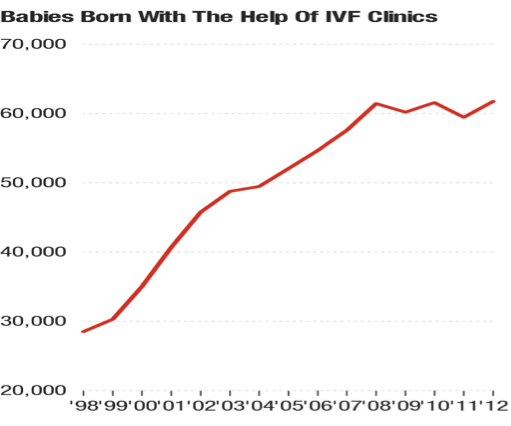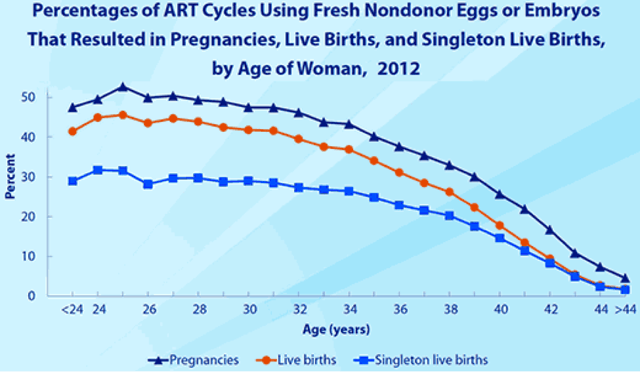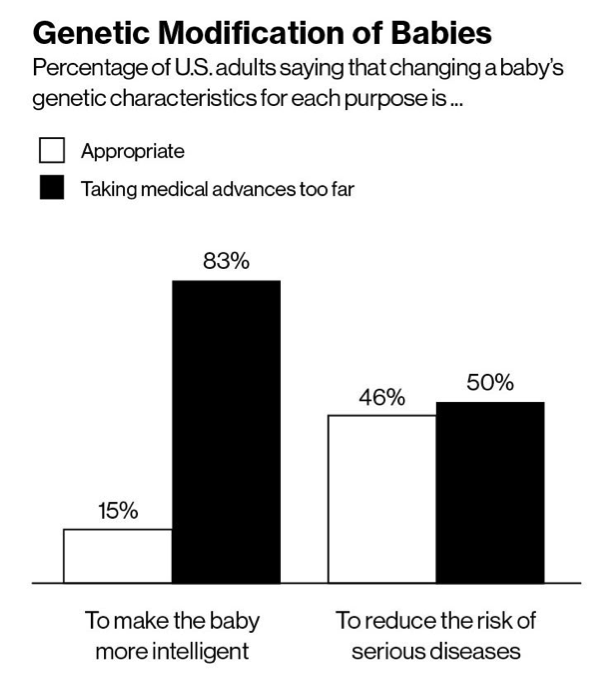
In my last blog, we looked at how exponential tech impacts sex and dating.
In this blog, we'll look at:
- Reproduction without sex
- Freezing your eggs to extend your reproductive timeline
- Designer babies
- Making babies without eggs
Imagine a near future where the process of having a child is not left up to the vagaries of Mendelian genetics. After all, we strive to give our children the best possible education, clothing, food, and upbringing… why not have them start with the best possible genetic code as well?
Is this heresy or common moral sense?
Let's dive in -- there's a lot to consider.
P.S. Send any tips to our team by clicking here, and send your friends and family to this link to subscribe to Abundance Insider.
Reproduction Without Sex
Making a human is pretty straightforward -- it happens daily with no training. :)
Traditionally and evolutionarily, sex has been how humans have reproduced for millions of years… but this is changing fast.
Today, more couples than ever are turning to in vitro fertilization, or IVF, to conceive children.
IVF is an assisted reproductive technology where fertilization happens by manually combining an egg and sperm in a laboratory dish, and then transferring the embryo to the uterus.
In 2014, more than 65,000 babies were conceived with the help of IVF representing 1.6 percent of the 4.0 million births in the U.S.

(IVF trends over time)
Over the past decade, the number of IVF procedures have skyrocketed nearly 50% from 113,000 in 2003 to over 165,000 today.
This trend has been catalyzed on the back of decreasing costs of the procedure and increased pregnancy rates.
Over the past 10 years, IVF costs have fallen from $20,000 to ~$10,000 per procedure while pregnancy rates have increased from 20% to >50%.
IVF in combination with an egg donor is creating an opportunity for the 6.1 million women in the United States who suffer from infertility issues or are too old to have a baby.
In 2015, over 17,000 IVF procedures used an egg donor.
IVF also allows couples to fertilize many eggs at a time (eight to 10 on average), grow them to the blastocyst stage, sequence a cell from each blastocyst and then select the healthiest for implantation into the mother's womb.
I believe that eventually IVF might in fact be the "standard" and most widely accepted way to reproduce.
Egg Freezing
As women continue to further their education and their careers, many women face deep anxiety when considering having children later in life since fertility rates decrease by two-thirds by the age of 40.

(Successful assistive reproductive technological pregnancies by age of women)
But one new technological solution might help solve this problem: the ability to freeze one's healthy eggs earlier in life.
Egg freezing has started to become a way for women to reproduce on a timetable of their own choice -- not dictated by their own biology.
The number of women choosing to freeze their eggs at fertility clinics in the U.S. grew more than sevenfold between 2009 and 2013.
.png?width=640&name=Untitled3%20(1).png)
(Egg freezing trends over time)
Carl Djerassi, inventor of the contraceptive pill, commented on this trend, saying, "In the next 20 years, more young people will freeze their eggs and [sperm] in their 20s, and bank them for later use. They will do away with the need for contraception by being sterilized, and withdraw their eggs and sperm from the bank when they are ready to have a child via IVF."
Designer Babies
If you had the ability to tinker with the genetics of your baby, would you?
What if you could prevent a hereditary disease? Might it become 'unethical' to NOT correct genetic errors?
Since we discovered CRISPR/Cas9, a tool used to "edit" the human genome with incredible precision, these questions are no longer theoretical and philosophical – they are very, very real.
Just three years after its initial development, CRISPR technology is already widely used by biologists as a kind of search-and-replace tool to alter DNA, even down to the level of a single letter.
By editing the DNA of these cells or the embryo itself (germline engineering), it could be possible to correct disease genes and pass those genetic fixes on to future generations.
Such a technology could be used to rid families of scourges like cystic fibrosis and muscular dystrophy.
This history-making medical advance could be as important to this century as vaccines were to the last.
By some measures, U.S. public opinion is not particularly negative toward the idea of genetically modifying babies.

(Genetic modification of babies, survey results)
A Pew Research survey carried out last August found that 46 percent of adults approved of genetic modification of babies to reduce the risk of serious diseases.
Interestingly, the same survey found that 83 percent said genetic modification to make a baby smarter would be "taking medical advances too far."
At least three other centers in the United States are working on germline engineering, as are scientists in China, in the U.K., and at a biotechnology company called OvaScience, based in Cambridge, Massachusetts, that boasts some of the world's leading fertility doctors on its advisory board and has raised over $132 million.
The objective of these groups is to demonstrate that it's possible to produce children free of specific genes involved in inherited disease.
If it's possible to correct the DNA in a woman's egg, or a man's sperm, those cells could be used in an in vitro fertilization (IVF) clinic to produce an embryo and then a child.
It might also be possible to directly edit the DNA of an early-stage IVF embryo using CRISPR.
Life as we know it is becoming programmable.
These changes are happening fast, in the next decade, or so… beyond that, in the far future, things get even crazier.
Reproduction and Exponential Tech
Exponential technologies in the next 20 years are going to play a huge role in the way in which we decided to bring life into this world. Here are three amazing new approaches that may represent the future of reproduction:- Making Babies With More Than Two People: This April, the world’s first baby was born from a new procedure that combines the DNA of three people. Nuclear DNA came from a mother and a father, and mitochondrial DNA was transferred into the fertilized egg from a third donor.
- Making Babies Without Eggs: Scientists out of the University of Bath say early experiments suggest it may one day be possible to make babies without using eggs. They have succeeded in creating healthy baby mice by tricking sperm into believing they were fertilizing normal eggs. In this scenario, two men could have a child, with one donating an ordinary cell and the other donating sperm. Or one man could have his own child using his own cells and sperm, with that child being more like a non-identical twin than a clone.
- Artificial Wombs: In the mid-1990s, Japanese investigators succeeded in maintaining goat fetuses for weeks in a machine containing artificial amniotic fluid. Today, it is possible for a preterm fetus to survive when removed from the mother at a gestational age of slightly less than 22 weeks. That’s only a little more than halfway through the pregnancy (normally 40 weeks). For moms reading this blog, imagine not having to carry a baby around for nine months at a time.
Implications
Humanity is moving from evolution by natural selection (Darwinism) to evolution by intelligent direction at an accelerating pace.
From the advent of birth control in 1960, to CRISPR/Cas9 today, we as humans are being given tremendous control on how and when we choose to reproduce.
Technologies like CRISPR/Cas9 cut to the core of who we are as people, and it makes us ask whether humans should be exercising that kind of power, especially with features like eye color, hair color, height, intelligence, and athletic ability.
These are moral and ethical issues – but in any case, it's clear that technology is forever changing the course of human development and procreation.
Join Me
1. A360 Executive Mastermind: This is the sort of conversation I explore at my Executive Mastermind group called Abundance 360. The program is highly selective, for 360 abundance and exponentially minded CEOs (running $10M to $10B companies). If you’d like to be considered, apply here.
Share this with your friends, especially if they are interested in any of the areas outlined above.
2. A360 Digital Mastermind: I’ve also created a Digital/Online community of bold, abundance-minded entrepreneurs called Abundance 360 Digital (A360D).
A360D is my ‘onramp’ for exponential entrepreneurs – those who want to get involved and play at a higher level. Click Here to Learn More.
P.S. I've just released a podcast with my dear friend Dan Sullivan called Exponential Wisdom. Our conversations focus on the exponential technologies creating abundance, the human-technology collaboration, and entrepreneurship. Head here to listen and subscribe.
Topics: Exponentials Medicine/Health








